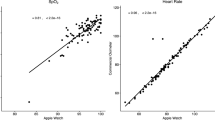Abstract
As new customer health devices have been spread throughout the consumer market in recent years, it now needs to be evaluated if they also fulfill the requirements of clinical use. The Apple Watch Series 6 provides a new health feature with its oxygen saturation measurement. The aim of this prospective, investigator-initiated, single-arm study was to compare transcutaneous oxygen saturation measurements using the Apple Watch 6 with the conventional method of pulse oximetry in patients with congenital heart disease. Patients of any age presenting at the Leipzig Heart Center, Department for pediatric cardiology, were included. After obtaining informed consent, the routine oxygen saturation measurement with the pulse oximeter was taken and simultaneously three measurements with the Apple Watch. A total of 508 patients were enrolled. Comparing children and adults in terms of measurement success shows a statistically significant difference with a higher proportion of unsuccessful measurements in children, but no difference concerning correct versus incorrect Apple Watch measurements. Noticeable, strapping on the watch properly around the patient’s wrists significantly improved the measurements compared to a watch only laid on. The study demonstrated that oxygen saturation measurement with the Apple Watch 6 is not yet up to the medical standard of pulse oximetry, too large a proportion of the measurements remain either unsuccessful or incorrect. While a high proportion of unsuccessful measurements in children can be attributed to movement, the cause in adults usually remains unclear. Further influencing factors on a correct, or successful measurement could not be found.








Similar content being viewed by others
References
Wuerthele M (2017). First FDA-certified Apple Watch accessory is AliveCor's Kardia Band EKG meter. https://appleinsider.com/articles/17/11/30/alivecor-kardia-band-ekg-meter-is-the-first-fda-certified-apple-watch-peripheral. Accessed 5 Nov 2021
Ed. Apple (2021). How to use the Blood Oxygen app on Apple Watch Series 6 or Series 7. https://support.apple.com/en-us/HT211027. Accessed 5 Nov 2021
Ed. Apple (2020). Apple Watch Series 6 delivers breakthrough wellness and fitness capabilities. https://www.apple.com/newsroom/2020/09/apple-watch-series-6-delivers-breakthrough-wellness-and-fitness-capabilities/. Accessed 5 Nov 2021
Cohen J (1988) Statistical power analysis for the behavioral sciences. Taylor & Francis Ltd, Milton Park
M Kobel KP (2021). Accuracy of the Apple Watch iECG in children with and without congenital heart disease. https://pubmed.ncbi.nlm.nih.gov/34468775/. Accessed 6 Nov 2021
Amirali Behzadi AS (2020). Feasibility and reliability of SmartWatch to obtain 3-lead electrocardiogram recordings. https://pubmed.ncbi.nlm.nih.gov/32906661/. Accessed 6 Nov 2021
Leonardo Zumerkorn Pipek RF (2021). Comparison of SpO 2 and heart rate values on Apple Watch and conventional commercial oximeters devices in patients with lung disease. https://pubmed.ncbi.nlm.nih.gov/34556765/. Accessed 6 Nov 2021
Ed. Apple (2021). Apple Watch Series 6—technical specifications. https://support.apple.com/kb/SP826?viewlocale=en_US&locale=de_CH. Accessed 5 Nov 2021
Author information
Authors and Affiliations
Contributions
CP study design and conduction, critical revision of manuscript. CP study conduction and paper draft.
Corresponding author
Ethics declarations
Competing interests
The authors declare no competing interests.
Additional information
Publisher's Note
Springer Nature remains neutral with regard to jurisdictional claims in published maps and institutional affiliations.
Rights and permissions
Springer Nature or its licensor holds exclusive rights to this article under a publishing agreement with the author(s) or other rightsholder(s); author self-archiving of the accepted manuscript version of this article is solely governed by the terms of such publishing agreement and applicable law.
About this article
Cite this article
Pätz, C., Michaelis, A., Markel, F. et al. Accuracy of the Apple Watch Oxygen Saturation Measurement in Adults and Children with Congenital Heart Disease. Pediatr Cardiol 44, 333–343 (2023). https://doi.org/10.1007/s00246-022-02987-w
Received:
Accepted:
Published:
Issue Date:
DOI: https://doi.org/10.1007/s00246-022-02987-w




